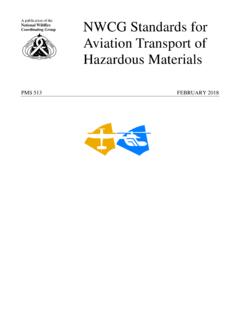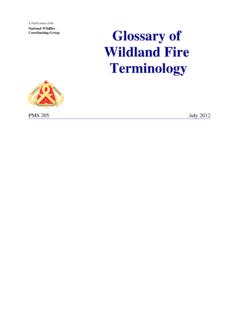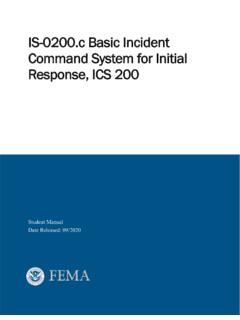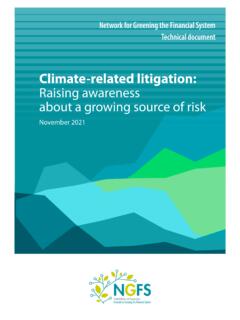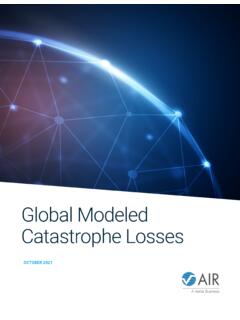Transcription of Incident Scenarios Collection for Public Safety ...
1 NISTIR 8181 Incident Scenarios Collection for Public Safety Communications Research Framing the Context of Use Yee-Yin Choong Shane Dawkins Kristen Greene Mary Theofanos This publication is available free of charge from: NISTIR 8181 Incident Scenarios Collection for Public Safety Communications Research Framing the Context of Use Yee-Yin Choong Shane Dawkins Kristen Greene Information Access Division Information Technology Laboratory Mary Theofanos Office of Data and Informatics Material Measurement Laboratory This publication is available free of charge from: June 2017 Department of Commerce Wilbur L. Ross, Jr., Secretary National Institute of Standards and Technology Kent Rochford, Acting NIST Director and Under Secretary of Commerce for Standards and Technolog This publication is available free of charge from: Scenarios ( Collection for Public Safety Communications Research (Framing the Context of Use VERSION: JUNE 2017 Contacts: This publication is available free of charge from: This document was developed by the Public Safety Communications Research (PSCR) Usability Team at the National Institute of Standards and Technology (NIST).))
2 National Institute of Standards and Technology Communications Technology Laboratory Gaithersburg, MD 20899 Yee -Yin Choong Industrial Psychologist Shane Dawkins Computer Scientist Kristen Greene Cognitive Scientist Mary Theofanos Computer Scientist ii This publication is available free of charge from: Table of Contents Contacts:..ii Revision Introduction and Scope .. 1 About the Scenarios .. 1 3 1. Apartment Building Fire ..3 2. Structure Fire - Future Technology Scenario ..3 3. Subway Fire ..4 4. WUI 5. WUI Fire - 6. WUI Fire - Mountain-West 7. WUI Fire - 8. WUI Fire - South-West 9. WUI Fire - South-West Region, 10. WUI Fire Border ..8 Law Enforcement .. 9 11. Active Shooter - Future Technology Scenario ..9 12. Active Shooter - Military 13. Barricade 14. Manhunt on Shooting 15. Mass Shooting and Bomb 16. Police Ambush ..13 17. 18. Search in a National Park*.
3 14 19. Shooting ..14 20. Terrorist Car 21. Traffic 22. Traffic Stop - Future Technology Scenario* ..16 23. Undercover Officer Future Technology 24. EMS-Heart 25. Medical Emergency Future Technology Scenario*..18 26. Routine Patient Services and Car Crash Scenario Future Technology Scenario ..19 Multi-discipline ..20 27. Bombings at a Planned 28. Earthquake Magnitude ..21 29. Earthquake Magnitude ..21 30. Earthquake Exercise Magnitude 31. Explosion at a Chemical 32. Explosion at a Chemical Plant Future Technology 33. 34. Hurricane Category iii 35. Hurricane Category 36. Overturned Tractor Trailer on 37. Personal Injury Collision with Hazards Future Technology 38. Pre-Planned Event: College Football Game* ..26 39. River 40. Winter Summary Scenarios by List of Tables Table 1. Summary Scenarios by Domain.. 29 This publication is available free of charge from: iv This publication is available free of charge from: Revision Record Version Number Revision Description Date Total of 40 Incident Scenarios were compiled with consistent attributes.
4 June 0 8, 2017 v This publication is available free of charge from: Introduction and Scope A project goal for the Public Safety Communications Research (PSCR ) Usability Team is to develop use cases for testing and evaluation of new and emerging Public Safety communications technologies. Toward this end, it is imperative to understand the context of use1.
5 The context of use of Public Safety systems must be considered at the forefront of technological development. Incident Scenarios provide a description of an environment in which Public Safety systems are designed to operate. The Scenarios help frame the context of use to better understand first responders tasks, ensuring that the design of a system will meet the needs of users once the system is implemented in a real-world environment. This document is a Collection of Public Safety Incident Scenarios collected from fire, EMS and law enforcement domains. Because this Collection helps illustrate the context of use and understand user tasks, it should prove helpful for designers, developers and researchers of Public Safety communications technologies. The Scenarios in this document were compiled from various sources (a mixture of generated and historical Scenarios ) in the Public Safety community, including the Department of Homeland Security SAFECOM program [1], the National Institute of Standards and Technology (NIST) Public Safety Communications Research (PSCR) program [2], and a NIST PSCR Security Team workshop report [3]2.
6 Additional Scenarios were compiled based on publicly available After Action Reports (AARs) of real-world Public Safety incidents from the last twenty years, focusing primarily on incidents within the past ten years [see Bibliography 4-26]. The selection of AARs includes a wide variety of incidents from fire, emergency medical services (EMS), and law enforcement. The AARs also cover urban, suburban, and rural regions across the United States ( ) . While this Collection of Scenarios does not cover all possible activities and situations, they represent a variety of realistic incidents, activities, and responses that involve Public Safety agencies and personnel. This Collection is intended to be a living document, and will be updated as new Incident reports become available. About the Scenarios In reviewing these numerous Scenarios , we found common attributes that would be useful for future use case development for testing and evaluation of Public Safety communications technologies.
7 The attributes included in each scenario are those that would be important to a 1 For a detailed discussion on the context of use, see the Usability Handbook for Public Safety Communications, Public - Safety -communications2 Scenarios from sources [1], [2], and [3] were copied as-is from original sources. 1 This publication is available free of charge from: first responder in completing their Incident response tasks. Therefore, where such attributes are available, they are taken directly from their original source, such as: Vignette Region and Location Time, day and month of the year Incident duration Actors Resources Complicating factors or considerations as the Incident unfolds Incident outcomes Each scenario starts with key information3 about the environment where and when the Incident took place: Region for example, Midwest, New England Location Metropolitan city, Urban, Suburban, Rural Time of year for example, weekday, January, hurricane season We define Region using the Census Bureau s designated 4 regions and 9 divisions within those regions [4].
8 Remaining attributes are integrated into the Incident description and considerations that were discovered as the Incident unfolded. The Scenarios in this document fall into one of four categories, and are organized as: Fire Scenarios Law enforcement Scenarios EMS Scenarios Multi-discipline Scenarios Within these categories, the Scenarios are grouped by type of Incident , for example, Wildland Urban Interface (WUI) fire, and listed alphabetically. A table at the end of the document shows an aggregate of the Scenarios by domain and their corresponding sources. NOTE: The focus of each source varied; as such, the Scenarios differed in overall theme (for example, looking towards future technologies) and levels of detail provided. Some necessary modifications were made to ensure a consistent set of attributes across Scenarios . The modifications did not change the main narrative of the original scenario or Incident . 3 Not all Scenarios in the source references contained each attribute.
9 Missing information is labeled with n/a (not available). In addition, SI units are not provided as English units are common nomenclature for first responders in North America. 2 FIRE This publication is available free of charge from: 1. Apartment Building Fire* Region: n/a Location: Metropolitan city Time of year: n/a At 15:17, a 9-1-1 call from a cab driver indicated that the apartment building on a street in downtown is smoking and appears to be on fire. The dispatcher notified the fire department to send a fire engine and a fire ladder, and to send the battalion chief as the fire's Incident commander.
10 The nearest ambulance was alerted by the dispatcher to proceed to the scene. The dispatcher notified a neighboring jurisdiction to also send an engine to the fire. Considerations: The building had eight apartments on each of three floors. The main fire was discovered in a second floor apartment kitchen where an electric range was burning. Two adults and two children were trapped in the apartment suffering from smoke inhalation. Social media messages were used to post the status of the response. Source: [1] [2] 2. Structure Fire - Future Technology Scenario* Region: n/a Location: n/a Time of year: n/a During a response to a building fire, a firefighter uses an app on his/her mobile device to navigate through the building as well as provide firefighter location to the fire Incident commander. Considerations: Does the assessment change if the structure is a small house vs. apartment vs. commercial structure? Source: [3] * Scenarios from sources [1], [2], and [3] were copied as-is from original sources.










